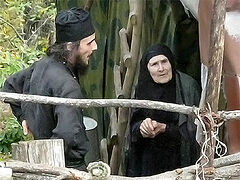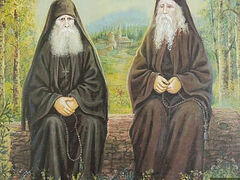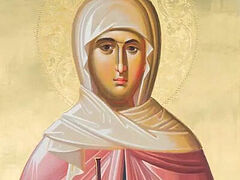The monastic endurance test
A lonely monk resides at the top of the mountain in his tiny celestial monastery. He’s the only resident and also a priest. Nothing but endless precipices yawning all around. For over eight centuries, this skete has been standing high above, like a lighthouse for the hesychasts who strive in asceticism in the nearby caves.
Protosinghel Modest (Ghinea) knows the hermits residing there today. From time to time, he brings them food in secret hideaways deep inside the woods. Occasionally, they come up to the monastery themselves. But they always do it discreetly, when only a couple of people are gathered for the services, under the cover of night. They huddle themselves in the corner of the church, standing silently. They pray in silence and leave at dusk. They take Communion once a year from the hands of Fr. Modest, the abbot of Cetățuia Negru Vodă Monastery.1
The monastery clinging to the rock consists of a few cells, steep paths, and two tiny churches: a new wooden one, built in the Maramureș style, and an ancient rock-hewn church where service to God has continued uninterrupted for centuries, beginning from the time of the Dacian pagan priests.2 There are no other buildings. Even planting an orchard is impossible as there’s nothing but dry rock throughout. There’s no water source, not a single spring anywhere on this monastery mountain. A little water is pumped from the valley below into a pool cut in the rock by the Dacians two and a half thousand years ago.
 Ancient cave church of Cetățuia Negru Vodă Monastery
Ancient cave church of Cetățuia Negru Vodă Monastery
Its living conditions are grim. Only a select few can endure them. Cetățuia is a trial test of monasticism: “When someone perseveres here, amidst these challenges, it means he deserves to be called a monk,” says Bishop Calinic of Argeș—and the novices who are unable to withstand this trial are sent to other monasteries. So, the monastery abbot Fr. Modest remains alone again, forever alone. Unshaken in his faith, he came here twenty-six years ago and never left.
Cetățuia is a trial test of monasticism
Even if he wanted, he wouldn’t be able to leave for even a day, because there’s no one else to serve the Liturgy. Besides, he can’t abandon the faithful who climb the mountain and seek him out. He can’t leave these blessed places, either—the caves, and their hermits…
Fools for Christ’s sake
As for serving the Liturgy in this tiny, narrow, and dark church with its windows opening up to the Divine panorama of the surrounding world… Earth can’t be seen from here. There’s nothing but the undulating mountain ridges and the woods floating above the slate-gray fog.
“Can you imagine what a Divine miracle it is for a priest to serve Liturgy in the presence of this kind of beauty? Even when I serve alone, I’m always overjoyed,” confesses Abbot Modest.
 A view from Cetățuia Negru Vodă monastery
A view from Cetățuia Negru Vodă monastery
Somewhere far below, where the torn rags of rising fog are still hanging suspended in the air, small dugouts cling to the bottom of the monastery’s mountain. That’s where I started my ascent along the steep and twisty path. A broad valley of the Dâmbovița River spreads out here, cars loudly race one another along the highway, and the Roma village of Cetățeni dazzles, with barbecues and electrifying music over the weekend...
 Ascent to Cetățuia Negru Vodă Monastery. The inscription reads: “Man, death is near. 1963. Wanderer, remember death”
Ascent to Cetățuia Negru Vodă Monastery. The inscription reads: “Man, death is near. 1963. Wanderer, remember death”
This is one slope of the monastery mountain, the most famous one. But only few people know what’s on the other side, with the completely wild gorge that spreads out there. It’s been known as the Valley of Cells since ancient times, and so it remains for the locals. Every Roma spoon-maker from Cetățeni knows that “behind” the mountain lies a valley with the cells of Dacian priests and people of “Black Voivode,” or Negru Vodă. Everyone knows about the caves, but few dare approach them.
These places aren’t for scenic walks, with direction signs and well-trodden paths
Gabriel Tinka, a parishioner of the church in Cetățeni, says the people are really lacking courage. Only a few of the Roma he knows would risk trekking through the area. These places aren’t for scenic walks, with direction signs and well-trodden paths. It’s too dangerous, with nothing but rocks and trees barely clinging to the steep slopes. On top of that, the area is teeming with wildlife, as if guarding this holy place.
 Approaching Cetățuia Negru Vodă Monastery
Approaching Cetățuia Negru Vodă Monastery
The abbot is coming with me to show me the Valley of Cells from the highest mountain point, the location of the memorial cross known these days as the “Cross of Desires.”
 Memorial cross in Cetățuia Negru Vodă Monastery
Memorial cross in Cetățuia Negru Vodă Monastery
The Valley of the Cells… It spreads before our eyes here. A bottomless gorge, heavily wooded, and Cetățuia Creek rushing along the bottom, parallel to Dâmbovița. It seems incredible that in this narrow two-and-a-half-mile abyss, just fifteen miles from the town of Câmpulung and right next to the national Rucăr-Bran highway, with its thousands of cars tearing along, this obscure gap is inhabited by hermits—in our twenty first century! A hotbed of hesychasm, detached from the rest of the world.
 Cetățuia Negru Vodă Monastery. The Valley of Cells is on the right
Cetățuia Negru Vodă Monastery. The Valley of Cells is on the right
Fr. Modest knows them personally. The last three hermits arrived here in 1998 and have remained in the caves ever since. They haven’t seen anyone from the outside world except him, and even he sees them rarely, when he brings them rusks and Holy Communion. Well, perhaps some wandering pilgrim, lost at night on his way to the monastery, could also encounter them.
“This whole Valley of Cells is replete with caves, whether natural or carved out by the hands of the ascetics. You can’t find its name on the map, but that’s what it’s been called here for centuries. I don’t even know the location of all of them. There are hidden ones, right there, in the bottom of the mountain,” says Fr. Modest, firmly holding onto the metal railing erected around the memorial cross to stop careless pilgrims from falling into the abyss.
“Clearly, these caves were originally inhabited by Dacian hermits. They were the renowned Thracian priests-ctistai (“founders of a family”),3 skilled in treating with healing herbs. There’s clear archeological evidence about the existence of this Dacian hermit enclave as early as the fifth century B.C.
So, what we see here is the natural succession of faith from Dacians to Christians. The Patericon says the Christian hesychast settlement in the Valley of Cells was founded before the thirteenth century.4 It’s the most ancient and strictest hesychast community in the Romanian land. As far back as at first millennium, righteous Greeks traveled here from Mt. Athos in search of theosis and strict manner of living. These “fools for Christ’s sake” would seal themselves inside the caves, leaving only a small opening to let the fresh air in, and for do-gooders to deliver some food to them by rope. These hermits were called “kellioti” by the locals—people residing in cave cells. Many of them attained a measure of holiness and became renowned.
The entire Valley of Cells is officially recognized as an archeological monument of national significance today, with its Dacian fortress, settlements of the La Tène culture, Christian fortress, cells, and the monastery that has existed there since 1215, from the time of Negru Vodă.
Besides, there’s a unique phenomenon observed exclusively in this gorge: Many unusual medicinal herbs growing seemingly out of place there have been found all across the valley’s two-and-a-half miles. There’s no explanation from the scientific, botanical point of view. A botany teacher from Câmpulung showed us a table with dozens of ancient types of plants that aren’t actually native to this area. Some locals go there solely for these miraculous herbs. I know a hermit named Fr. Pamvo who collects them as well.
Looking for medicinal herbs, people constantly stumble upon ancient human remains and bring them to me. I keep them in a special place. We’ll take them later to be examined. The places where they were found are marked and we’ve begun to make special maps. I’m not lacking in patience, and I won’t be going anywhere else. All in due season.
Venerable Mavra and the wolves
The memorial cross, towering at the top of the rock named the Throne of Negru Vodă, soars high above the rest of the mountain, with only skies above. Seventy-five years ago, in the beginning of Great Lent, a monk named Pimen (Bărbieru) decided to follow the ancient monastic tradition and retire into seclusion for the whole length of the holy Forty Days to pray in earnest. Lowering himself down from this rock on a rope, he unexpectedly discovered a cave holding the incorrupt relics of the great Romanian saint Schemamonk Ioanichie of Muscel, the renowned Romanian saint.
Owing to the miraculous train of events that I have already spoken about in great detail, Fr. Modest, who was standing beside me, was able to uncover the relics, buried in a special place, for the second time in 1996.
It’s the mountain’s most notable cave of all. It’s considered a holy place, but it remains practically inaccessible due to its location on the mountain wall. Even Fr. Modest, throughout his twenty-six years here, managed to get there only twice. The only way for someone to get there is by lowering himself by a rope.
 The holy relics of Venerable Ioanichie the New of Muscel in a new church at Cetățuia Negru Vodă Monastery
The holy relics of Venerable Ioanichie the New of Muscel in a new church at Cetățuia Negru Vodă Monastery
Everyone remembers when the bun Blessed Mavra came here over the mountains and valleys in 1969 from as far as Nyamets Mountains (about 225 miles away).
“Fr. Dorotei (Bărbieru), another hermit from the Valley of Cells and the brother of Protosinghel Pimen who found the holy relics, told me this story. Mavra came from the area around Sihla Monastery in winter, when the snow cover was more than knee-deep. She came in the company of two wolves who guarded her and who she talked to as if they were humans.
She came in the company of two wolves who guarded her and she talked to them as if they were humans. She addressed them by name
Yes, hefty wolves. She addressed them by name. First of all, she inquired in the village below about a holy place called Cetățuia. Then she entered the cave church and stayed there for three days never rising up from her knees. Fr. Dorotei confessed her. She said that she had a calling all her life to come here, a place steeped in a thousand years of prayer. Then she took her wolves and returned to Sihla, hundreds of miles away, wading through the snowdrifts. Sihla documents state that she labored as a hermit-martyr till the end of her days.
 Cave church at Cetățuia Negru Vodă Monastery with mannequin monks
Cave church at Cetățuia Negru Vodă Monastery with mannequin monks
 The iconostasis of the cave church at Cetățuia Negru Vodă Monastery. Photo: Ruxandra Chiurtu
The iconostasis of the cave church at Cetățuia Negru Vodă Monastery. Photo: Ruxandra Chiurtu
Rusks for the saints
Every year, once winter arrives, the abbot starts collecting bread and cuts it into cubes to make rusks akin to artos bread. Next, he places them in a sunny spot to dry and then collects them in bags. He also puts a lump of salt in each bag.
Fr. Modest has difficulty walking. He has diabetes and has undergone several operations on his legs due to frostbite and the serious injuries he has repeatedly suffered during lengthy ascents up the mountains. Despite all this, he gathers the bags and delivers them to the hermits.
“I often wanted to bring them some simple fasting food, too, but they categorically refuse. They even resent it. Truth be told, they didn’t even ask for these rusks, but I persistently leave them at the designated spots. Food is completely irrelevant to them. They lick some salt from time to time and drink some water that I bring them, and that’s enough. They’re immersed in prayer. Our bodies don’t really need much—just to have the strength to pray.
If anyone ever stumbles upon them, they hide or run away, or even chase them away, and quite rudely, I’d say. But even if the hermits don’t communicate with people, it doesn’t mean they don’t love them. They love them dearly, and they were bestowed with a gift of prayer for all mankind. They cry when they pray. That’s what I heard from a hermit Pahomie who told me quite sternly: “You should understand, Father: Prayer without tears isn’t prayer!”
Pahomie came here accompanied by a wolf, too, from Sihastria Monastery, also in the Nyamets Mountains. It was two years ago last September that he passed away. He also walked across the mountains by foot for hundreds of miles. He walked only at night, and the wolf guarded him till his death.
Pahomie was tall, wiry, and strong. The sight of him somehow terrified me. I always saw his face bearing this sullen and pitiless expression. As soon as he opened his mouth, his deep and loud voice sounded like a thunder. His eyes, red from sleepless night vigils, flashed fire from underneath his bushy eyebrows.
I’ll say, I was somewhat afraid of him, especially seeing the wolf waiting for him up on the cliff. Only later was I able to perceive the innermost, hidden world of his soul. He was a man who lived in complete harmony with the surrounding world: with nature, and with the change of seasons… He used to get nervous whenever I offered anything to him and never complained, saying that his cave keeps him very warm without any fire in winter.
All-in-all, I had three short visits with him. We walked past roe deer, but they didn’t run away from us. I saw a lynx on a branch right above my head; it growled at us, ready to jump. But Blessed Pahomie slightly turned his head towards it and thundered loudly: “Heeey!”—and the lynx obediently lowered its head on its paws and sat there like a timid cat. It didn’t make another sound, but it didn’t leave either.
All the time I spent with him, we never spoke about the events of the world outside. These hermits… It seems they know everything about the world without a TV or any specific information about it.
I remember standing there at the cross with him once, gazing at the mountains. Few words were spoken, as usual. I was on the brink of despair: The monastery was in need of so many things and the brotherhood was so small… I found myself thinking of leaving the monastery for the first time, to go to Mt. Athos. I remember how Father then touched me on the shoulder. He’d never behaved so familiarly before. I couldn’t help but blurt out:
“I don’t know, Father… We’re sinners… Especially me. I’m the greatest sinner on earth!”
Tears were flowing freely. He listened to me, and then exclaimed, almost shouting:
“Do you hear, O venerable one? Know that the thistle has its own flower and fragrance! People are like thistles. Have you seen a thistle’s flower? Don’t you think it’s the most beautiful on Earth?”






